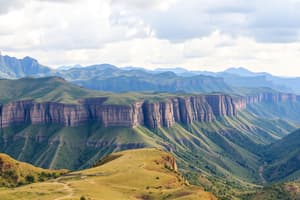Podcast
Questions and Answers
Mountains are elevated parts of the Earth's surface, characterized by steep slopes and prominent ______
Mountains are elevated parts of the Earth's surface, characterized by steep slopes and prominent ______
peaks
Mount Everest, located in the Himalayas range in Nepal, is the highest ______ on Earth, standing at an elevation of 8,850 meters (29,035 feet) above sea level.
Mount Everest, located in the Himalayas range in Nepal, is the highest ______ on Earth, standing at an elevation of 8,850 meters (29,035 feet) above sea level.
landform
Mountains are formed through processes such as ______, where rocks shift upward due to colliding tectonic plates.
Mountains are formed through processes such as ______, where rocks shift upward due to colliding tectonic plates.
faulting
Plateaus are large, continuous, elevated land areas with a relatively flat ______
Plateaus are large, continuous, elevated land areas with a relatively flat ______
Mountains provide habitats for various plant and animal species, while also influencing climate and weather patterns due to their elevation and proximity to ______ bodies.
Mountains provide habitats for various plant and animal species, while also influencing climate and weather patterns due to their elevation and proximity to ______ bodies.
Continental ______ are situated on the continents and can be further divided into subtypes like volcanic ______ and dissected ______.
Continental ______ are situated on the continents and can be further divided into subtypes like volcanic ______ and dissected ______.
______ are important for agriculture, transportation, and human habitation due to their flat and relatively smooth surface.
______ are important for agriculture, transportation, and human habitation due to their flat and relatively smooth surface.
______ provide habitats for various plant and animal species, while also influencing climate and weather patterns due to their topography and proximity to water bodies.
______ provide habitats for various plant and animal species, while also influencing climate and weather patterns due to their topography and proximity to water bodies.
______ have a more uniform climate compared to mountainous regions, making them suitable for large-scale agriculture and other human activities.
______ have a more uniform climate compared to mountainous regions, making them suitable for large-scale agriculture and other human activities.
______ can be formed by tectonic plate movements, volcanic activity, and erosion, with rivers and streams playing a significant role in shaping their landscape.
______ can be formed by tectonic plate movements, volcanic activity, and erosion, with rivers and streams playing a significant role in shaping their landscape.
Flashcards are hidden until you start studying
Study Notes
Major Landforms of the Earth: Mountains, Plateaus, Plains, and Valleys
The Earth's surface features various landforms that play a significant role in its geography, ecology, and economy. Some of the major landforms include mountains, plateaus, plains, and valleys. Each of these landforms has unique characteristics and impacts on the surrounding environment.
Mountains
Mountains are elevated parts of the Earth's surface, characterized by steep slopes and prominent peaks. They can be formed through tectonic plate movements, volcanic activity, and erosion. Some key features of mountains include:
-
Highest Landform: Mount Everest, located in the Himalayas range in Nepal, is the highest landform on Earth, standing at an elevation of 8,850 meters (29,035 feet) above sea level.
-
Formation: Mountains are formed through processes such as faulting, where rocks shift upward due to colliding tectonic plates.
-
Impact: Mountains provide habitats for various plant and animal species, while also influencing climate and weather patterns due to their elevation and proximity to water bodies.
Plateaus
Plateaus are large, continuous, elevated land areas with a relatively flat surface. They can be classified based on their geographical location and structure of rocks into different types, such as:
-
Intermontane Plateaus: These plateaus border mountain ranges or are situated partly within them, with nearly horizontal rock layers raised to very heights by vertical movements of the Earth's crust.
-
Piedmont Plateaus: Located at the foot of a mountain, these plateaus are often covered by alluvial deposits and are subject to erosion.
-
Continental Plateaus: These plateaus are situated on the continents and can be further divided into subtypes like volcanic plateaus and dissected plateaus.
Plains
Plains are vast, flat land areas with a very gentle slope. They can be formed through the accumulation of sediments over millions of years or by the erosion of higher landforms. Some characteristics of plains include:
-
Economic Importance: Plains are important for agriculture, transportation, and human habitation due to their flat and relatively smooth surface.
-
Climate: Plains have a more uniform climate compared to mountainous regions, making them suitable for large-scale agriculture and other human activities.
-
Erosion: Plains are susceptible to erosion, particularly due to wind and water, which can gradually wear down the landform over time.
Valleys
Valleys are elongated, depressions of the Earth's crust, often formed by the erosion of higher landforms. They can be created by processes such as faulting, volcanic activity, and the action of rivers and streams. Some key features of valleys include:
-
Formation: Valleys can be formed by tectonic plate movements, volcanic activity, and erosion, with rivers and streams playing a significant role in shaping their landscape.
-
Impact: Valleys provide habitats for various plant and animal species, while also influencing climate and weather patterns due to their topography and proximity to water bodies.
In addition to these major landforms, there are also minor landforms such as buttes, canyons, and basins. These landforms are also important for understanding the Earth's terrain and the processes that shape it over time.
Studying That Suits You
Use AI to generate personalized quizzes and flashcards to suit your learning preferences.




